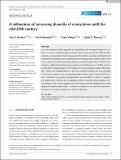Files in this item
A millennium of increasing diversity of ecosystems until the mid‐20th century
Item metadata
| dc.contributor.author | Santos Martins, Ines | |
| dc.contributor.author | Dornelas , Maria | |
| dc.contributor.author | Vellend, Mark | |
| dc.contributor.author | Thomas, Chris D. | |
| dc.date.accessioned | 2022-07-22T14:30:16Z | |
| dc.date.available | 2022-07-22T14:30:16Z | |
| dc.date.issued | 2022-07-22 | |
| dc.identifier | 280534865 | |
| dc.identifier | 8c5705ca-6fbe-411f-b02d-d549959854ff | |
| dc.identifier | 85134509538 | |
| dc.identifier | 000828672200001 | |
| dc.identifier.citation | Santos Martins , I , Dornelas , M , Vellend , M & Thomas , C D 2022 , ' A millennium of increasing diversity of ecosystems until the mid‐20th century ' , Global Change Biology , vol. Early View . https://doi.org/10.1111/gcb.16335 | en |
| dc.identifier.issn | 1354-1013 | |
| dc.identifier.other | ORCID: /0000-0003-4328-7286/work/116274888 | |
| dc.identifier.uri | https://hdl.handle.net/10023/25697 | |
| dc.description | Funding: Horizon Europe Marie Sklodowska-Curie Actions (Grant Number(s): 894644); Natural Sciences and Engineering Research Council of Canada; Leverhulme Centre for Anthropocene Biodiversity (Grant Number(s): RC-2018-021). | en |
| dc.description.abstract | Land-use change is widely regarded as a simplifying and homogenising force in nature. In contrast, analysing global land-use reconstructions from the 10th to 20th centuries, we found progressive increases in the number, evenness, and diversity of ecosystems (including human-modified land-use types) present across most of the Earth’s land surface. Ecosystem diversity increased more rapidly after ~1700CE, then slowed or slightly declined (depending on the metric) following the mid-20th century acceleration of human impacts. The results also reveal increasing spatial differentiation, rather than homogenisation, in both the presence-absence and area-coverage of different ecosystem types at sub-global scales - at least, prior to the mid-20th century. Nonetheless, geographic homogenization was revealed for a subset of analyses at a global scale, reflecting the now-global presence of certain human-modified ecosystem types. Our results suggest that, while human land-use changes have caused declines in relatively undisturbed or ‘primary’ ecosystem types, they have also driven increases in ecosystem diversity over the last millennium. | |
| dc.format.extent | 11 | |
| dc.format.extent | 5464892 | |
| dc.language.iso | eng | |
| dc.relation.ispartof | Global Change Biology | en |
| dc.subject | Ecosystem diversity | en |
| dc.subject | Anthropocene | en |
| dc.subject | Global change | en |
| dc.subject | Diversity metrics | en |
| dc.subject | Spatio-temporal | en |
| dc.subject | Spatial ecology | en |
| dc.subject | Land-use change | en |
| dc.subject | GE Environmental Sciences | en |
| dc.subject | QH301 Biology | en |
| dc.subject | DAS | en |
| dc.subject | SDG 15 - Life on Land | en |
| dc.subject.lcc | GE | en |
| dc.subject.lcc | QH301 | en |
| dc.title | A millennium of increasing diversity of ecosystems until the mid‐20th century | en |
| dc.type | Journal article | en |
| dc.contributor.sponsor | European Commission | en |
| dc.contributor.sponsor | The Leverhulme Trust | en |
| dc.contributor.institution | University of St Andrews. School of Biology | en |
| dc.contributor.institution | University of St Andrews. Centre for Biological Diversity | en |
| dc.contributor.institution | University of St Andrews. Fish Behaviour and Biodiversity Research Group | en |
| dc.contributor.institution | University of St Andrews. Marine Alliance for Science & Technology Scotland | en |
| dc.identifier.doi | https://doi.org/10.1111/gcb.16335 | |
| dc.description.status | Peer reviewed | en |
| dc.identifier.grantnumber | 894644 | en |
| dc.identifier.grantnumber | en |
This item appears in the following Collection(s)
Items in the St Andrews Research Repository are protected by copyright, with all rights reserved, unless otherwise indicated.

